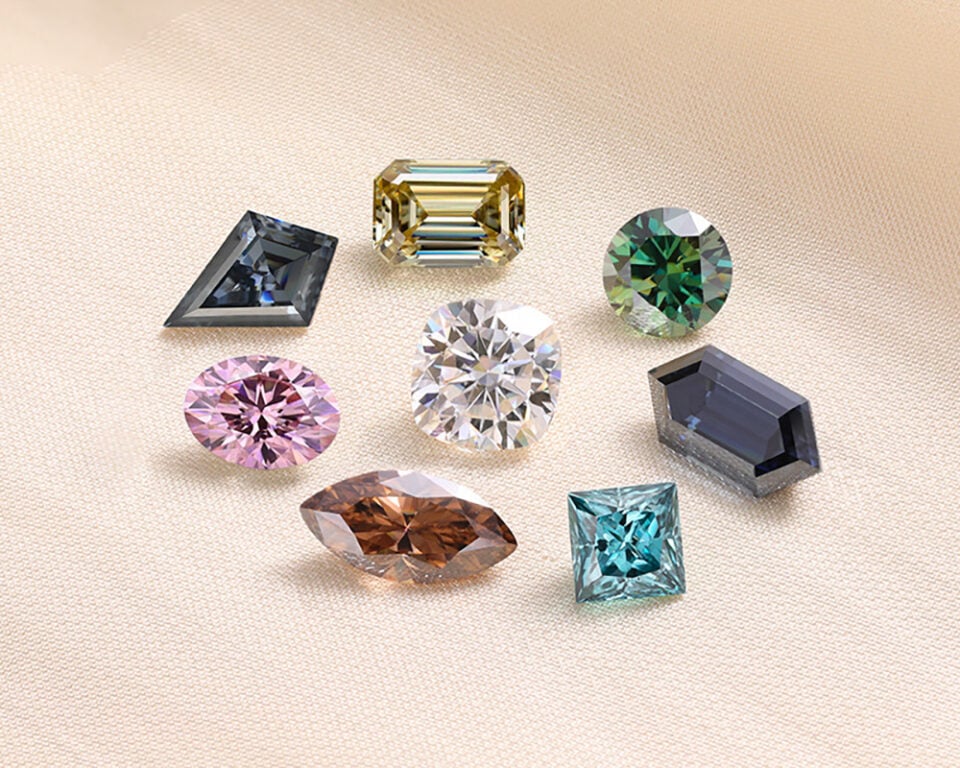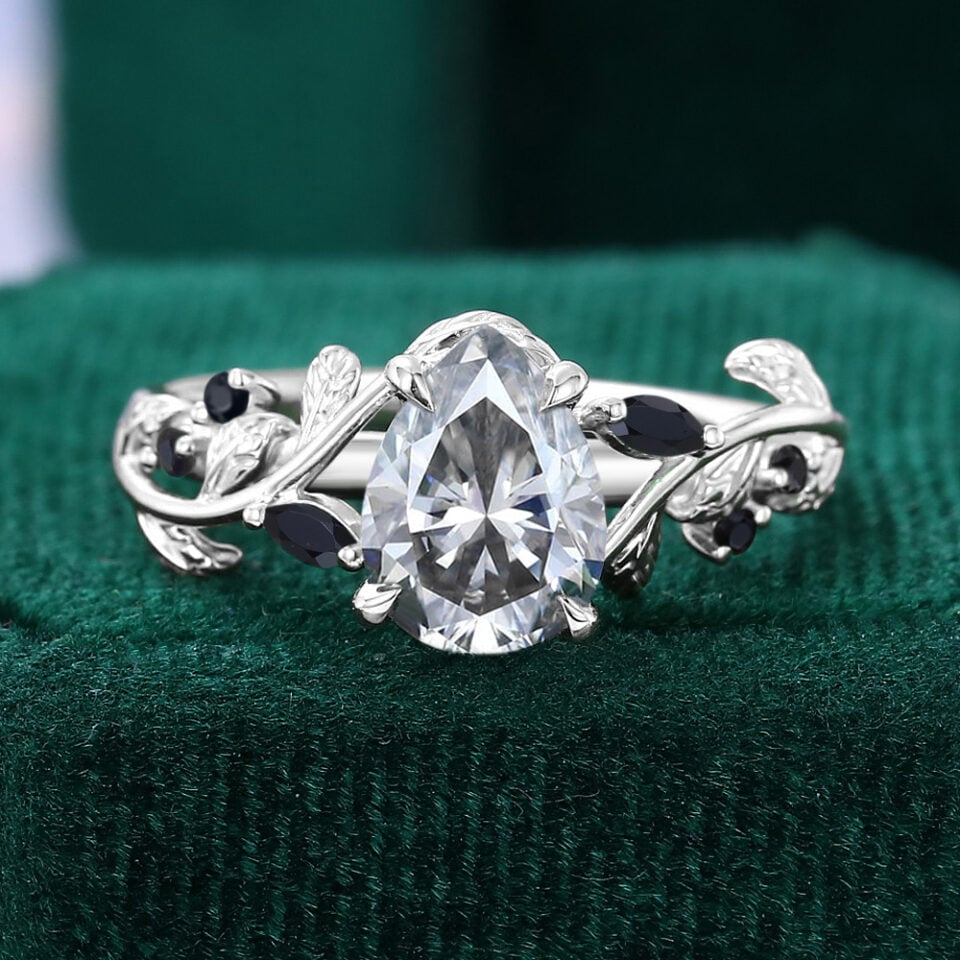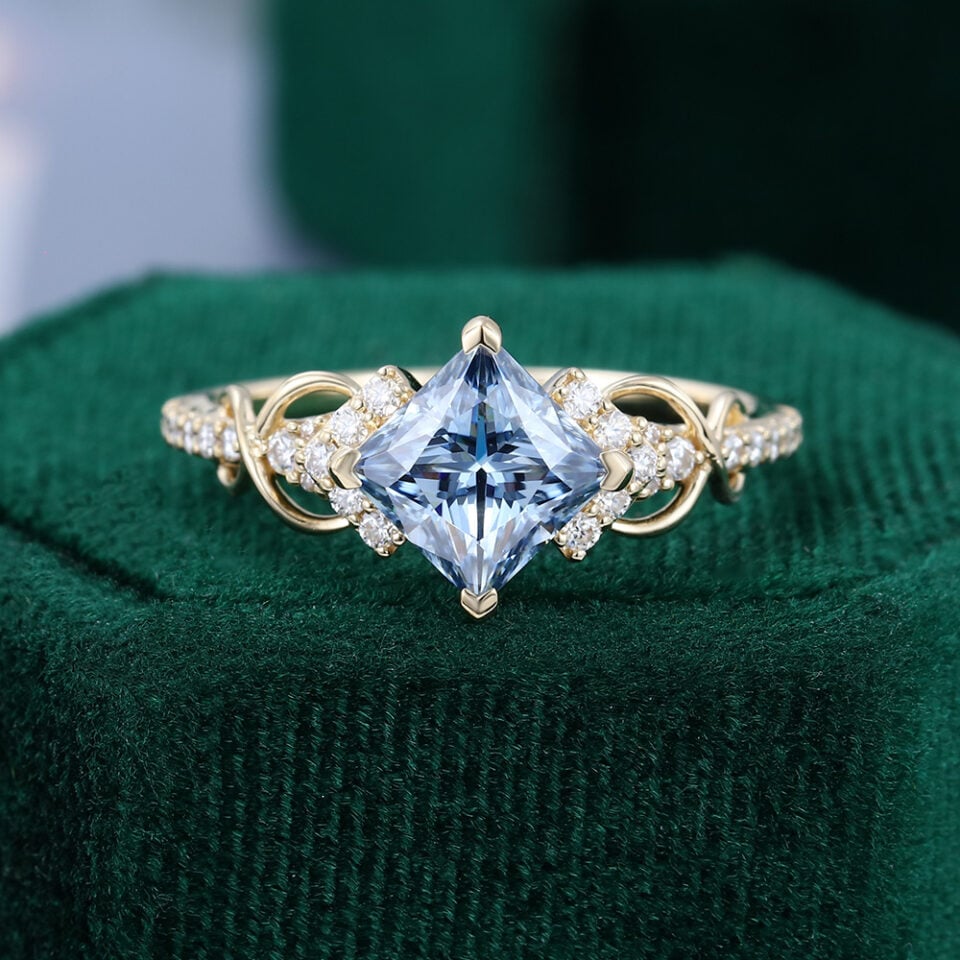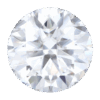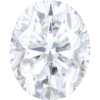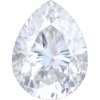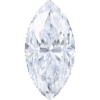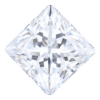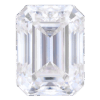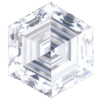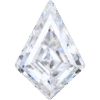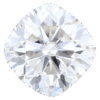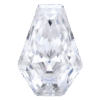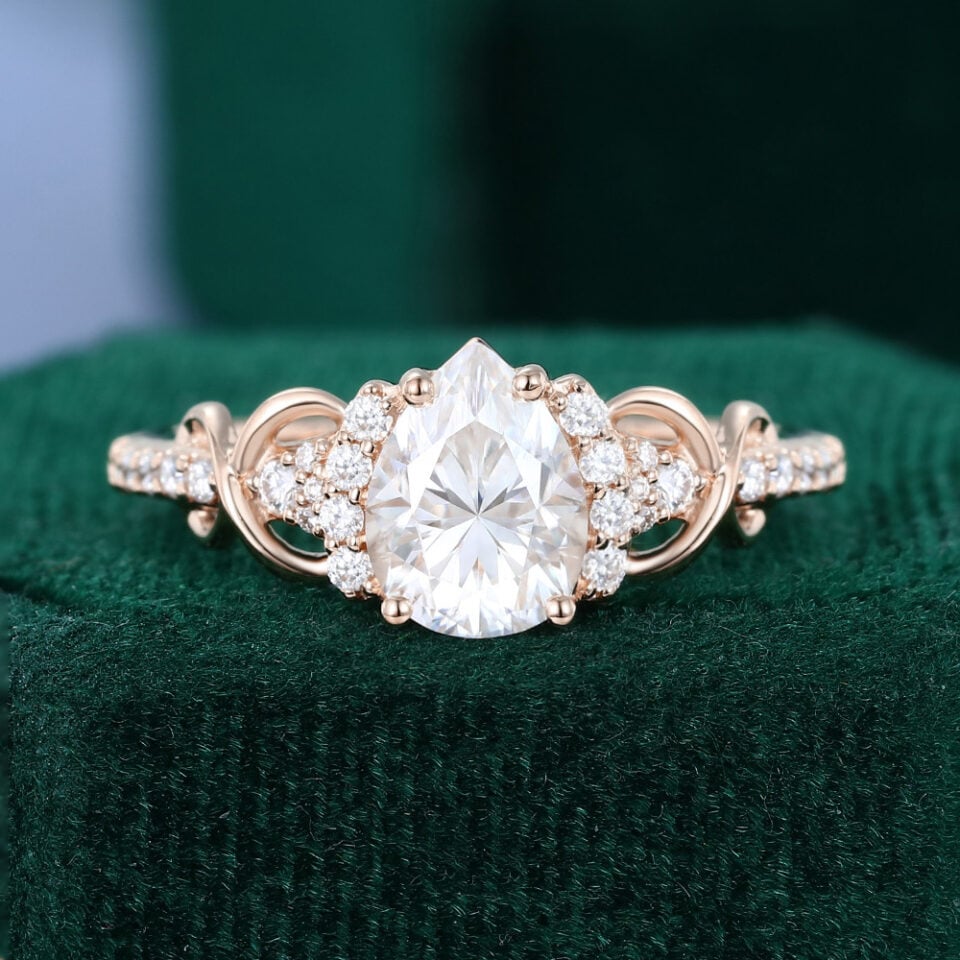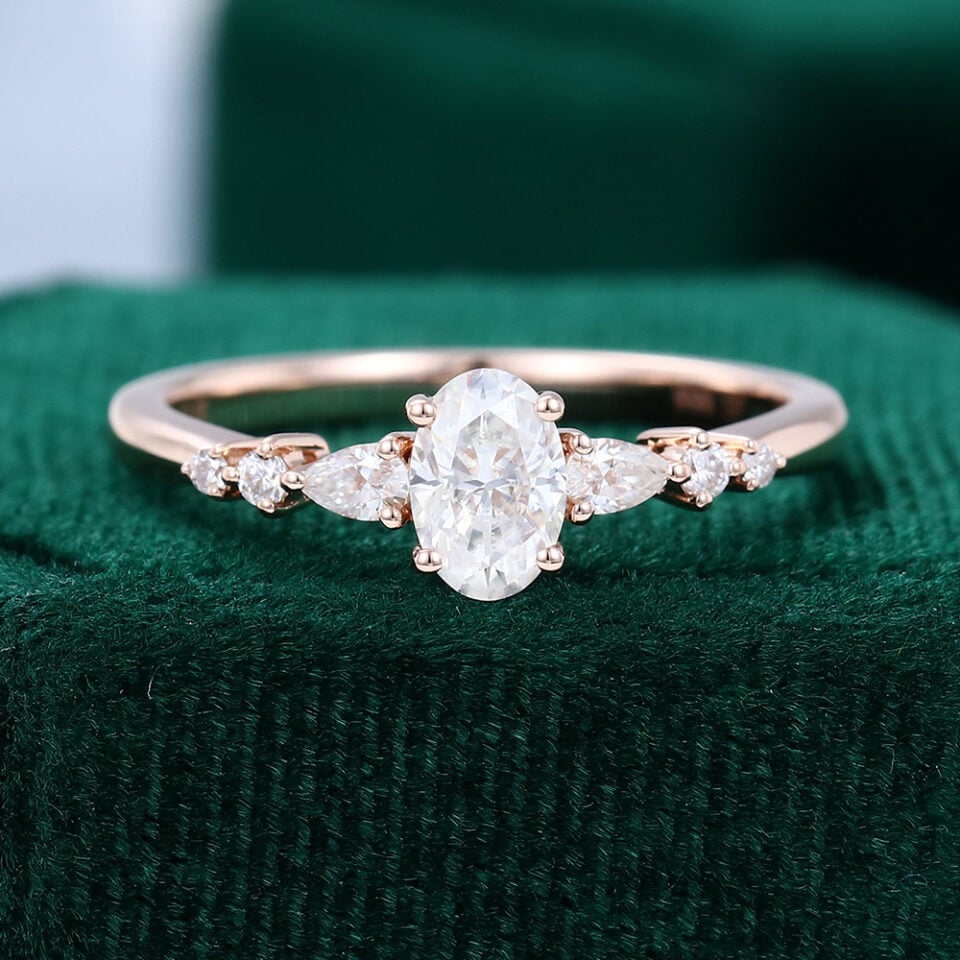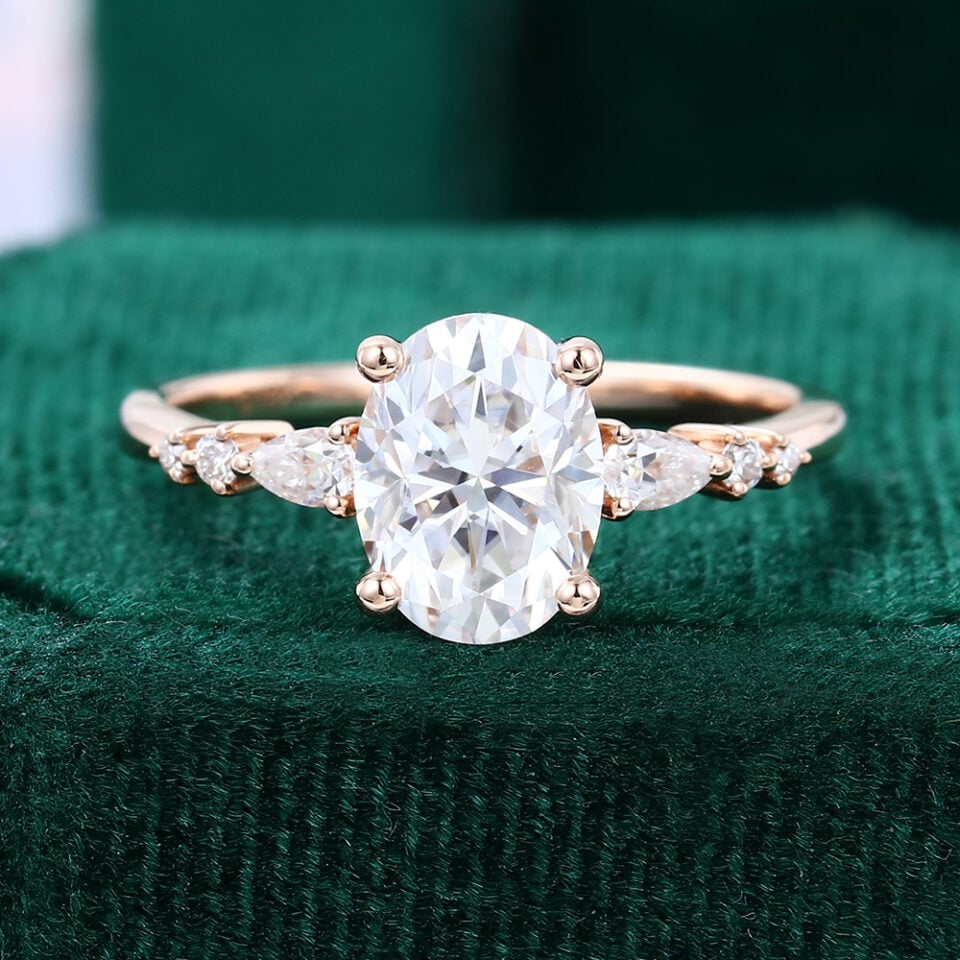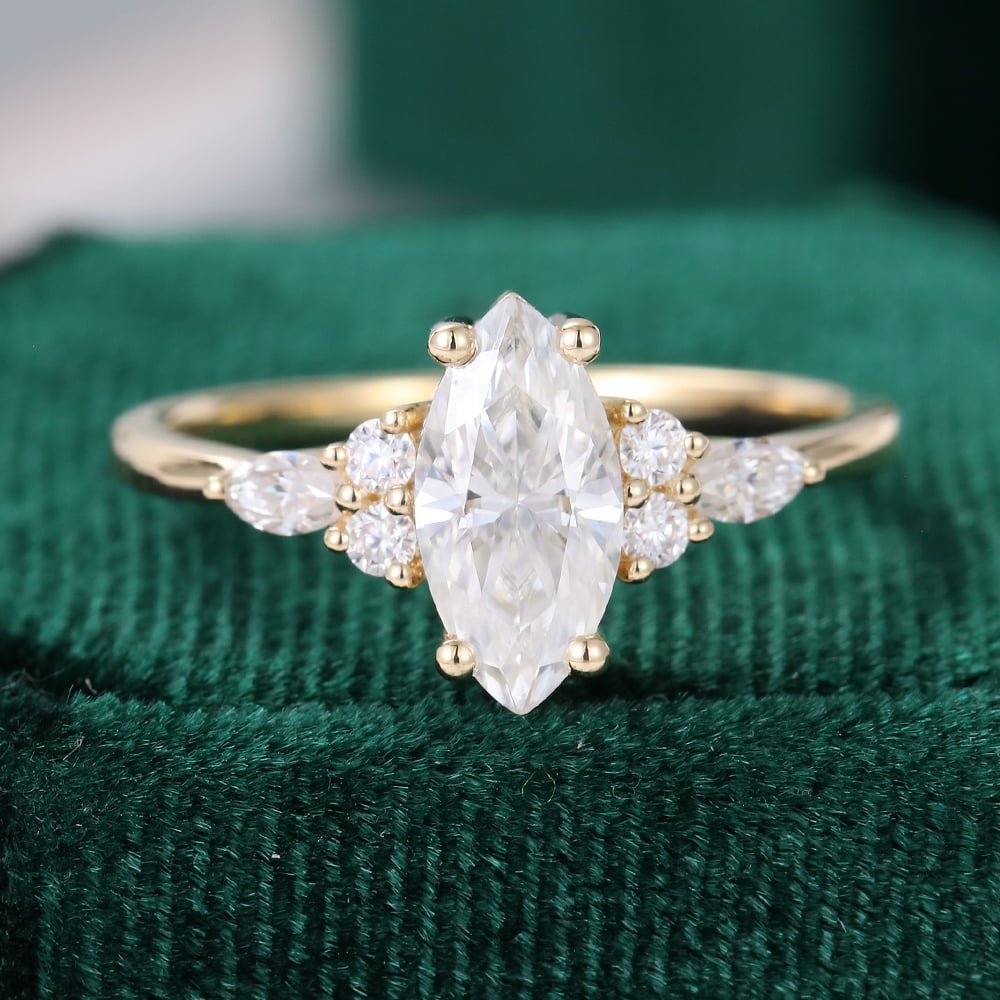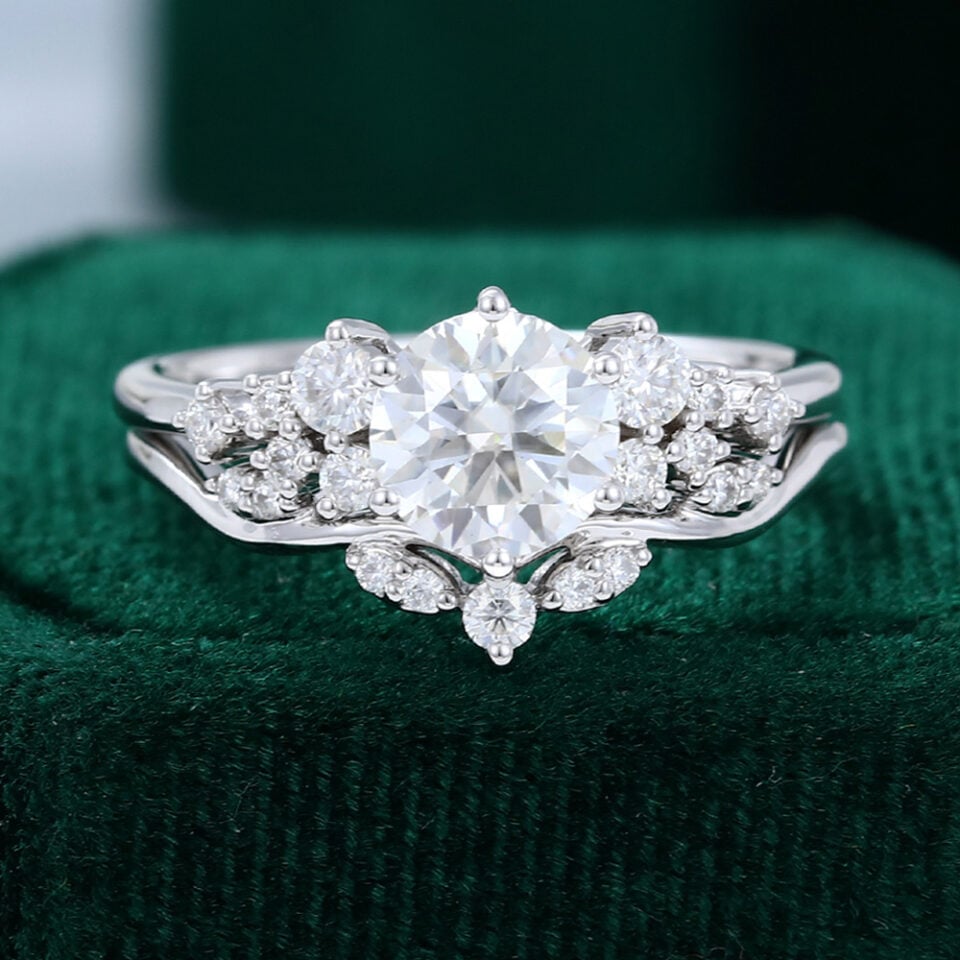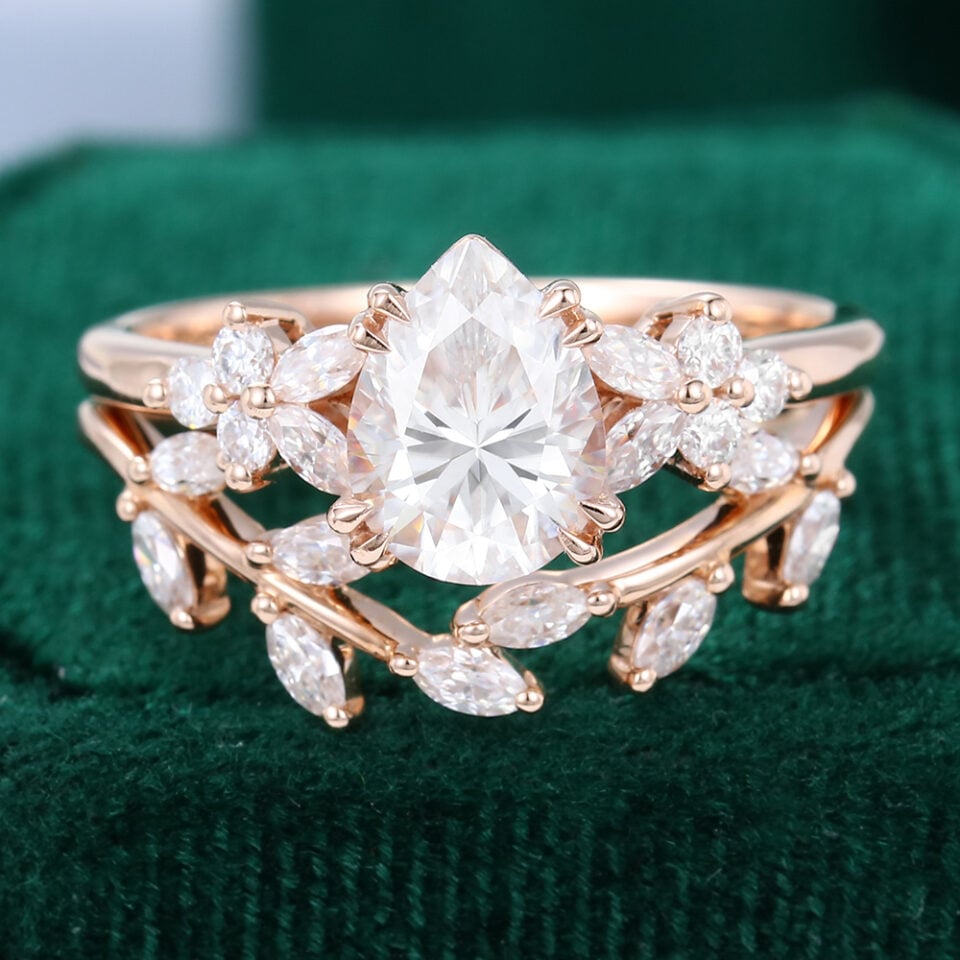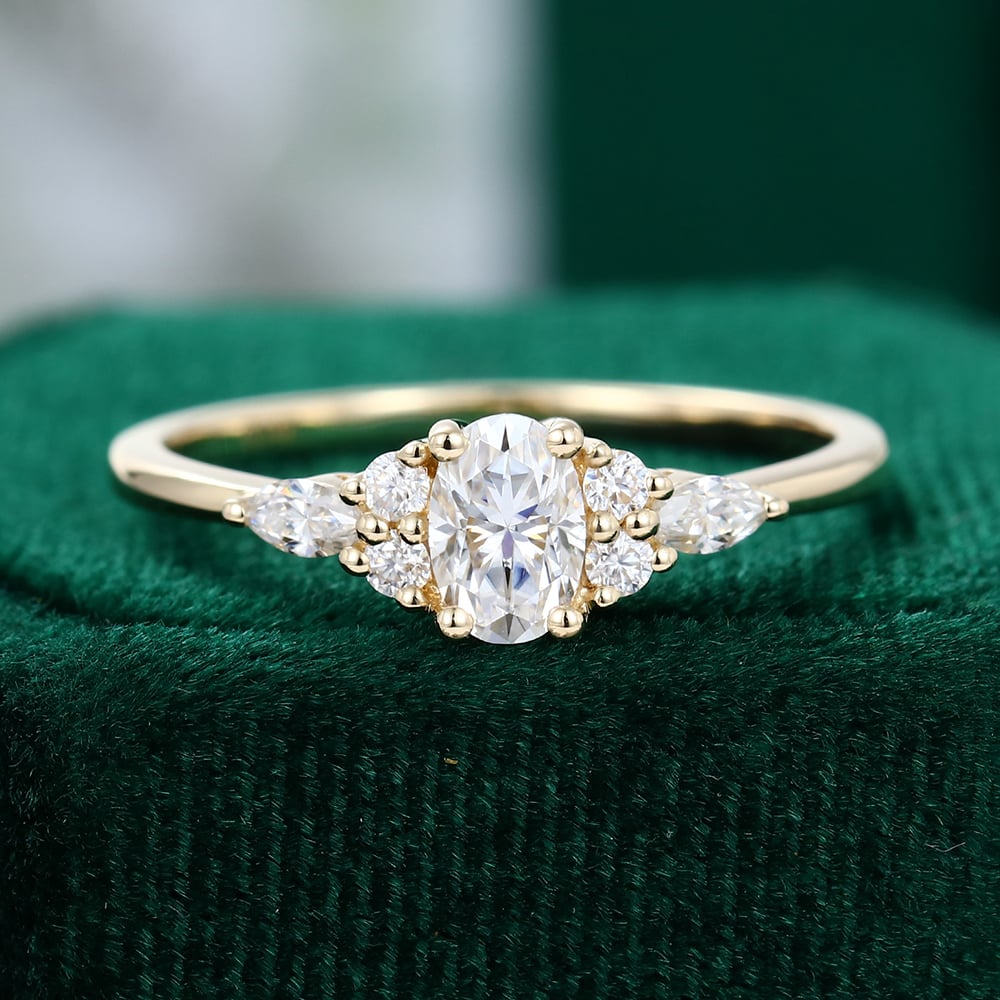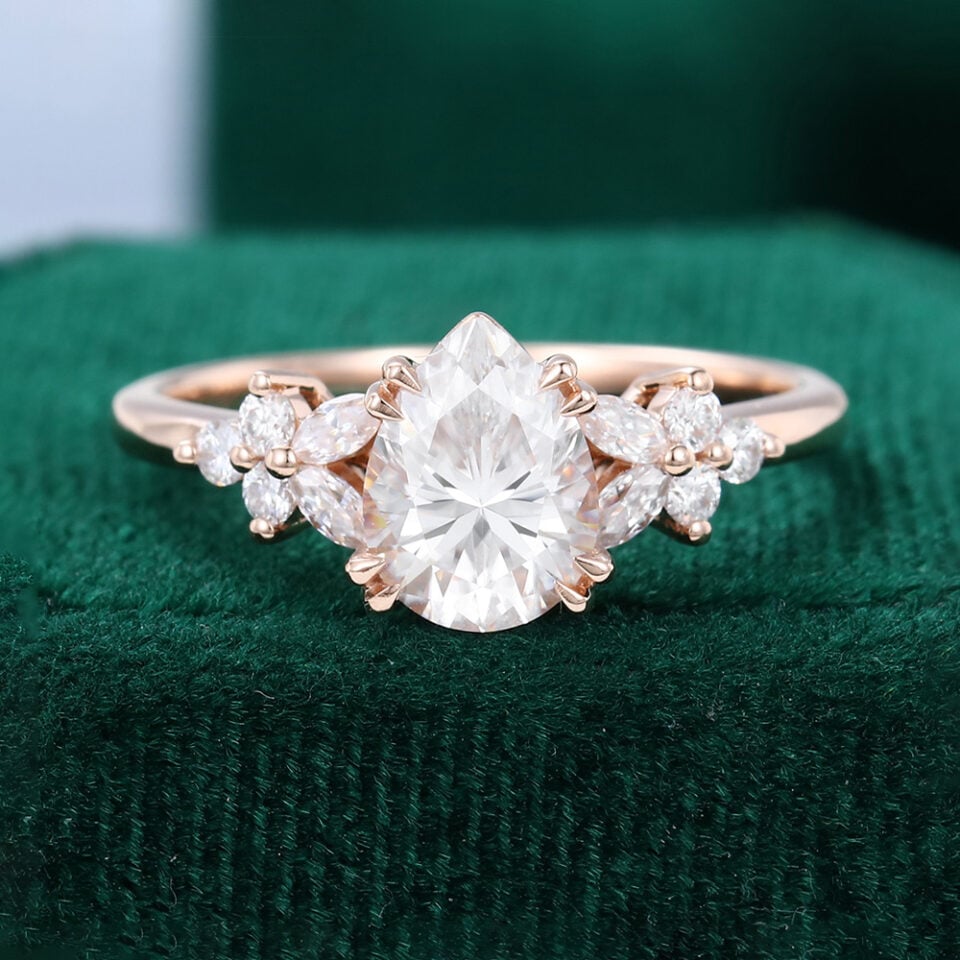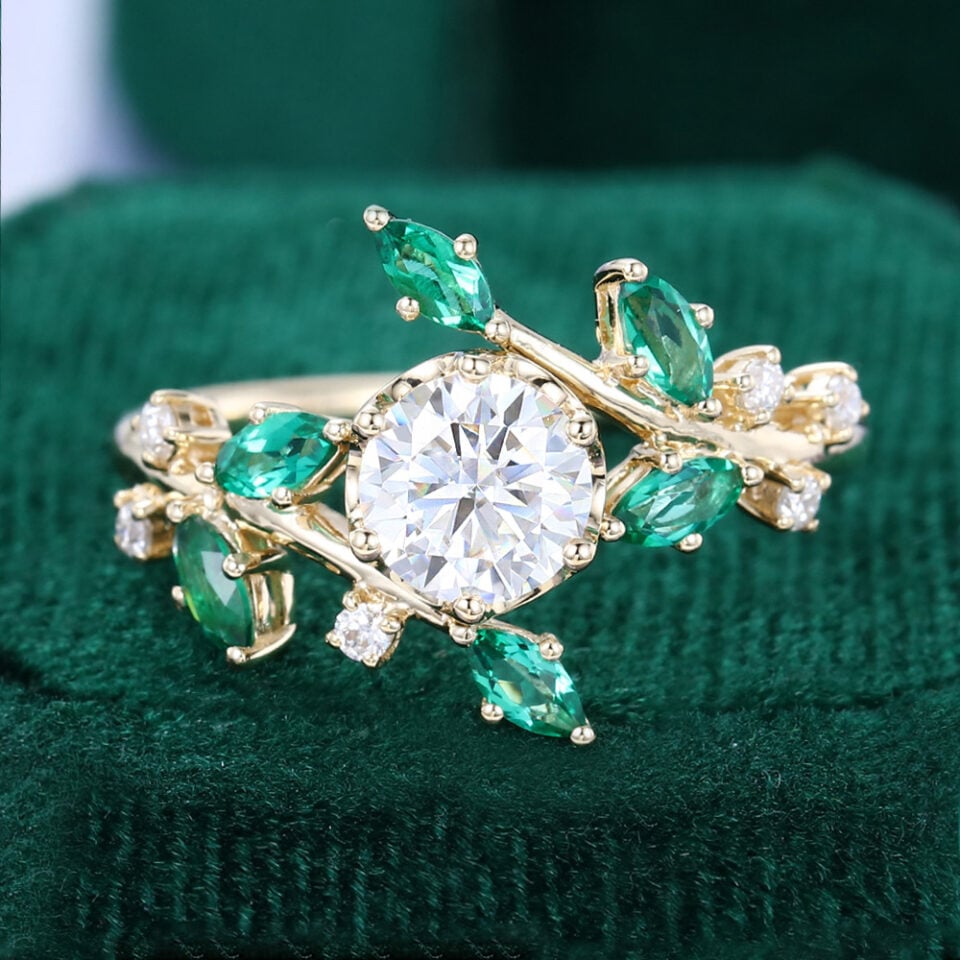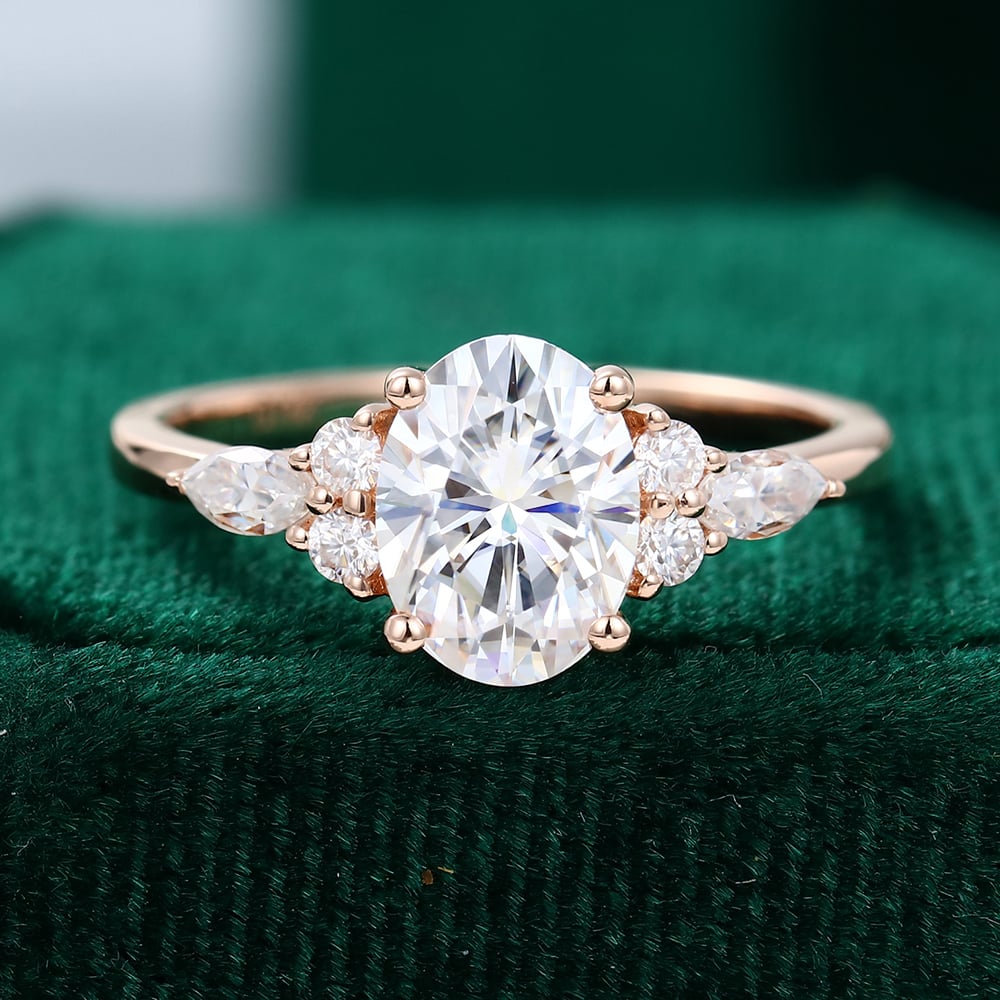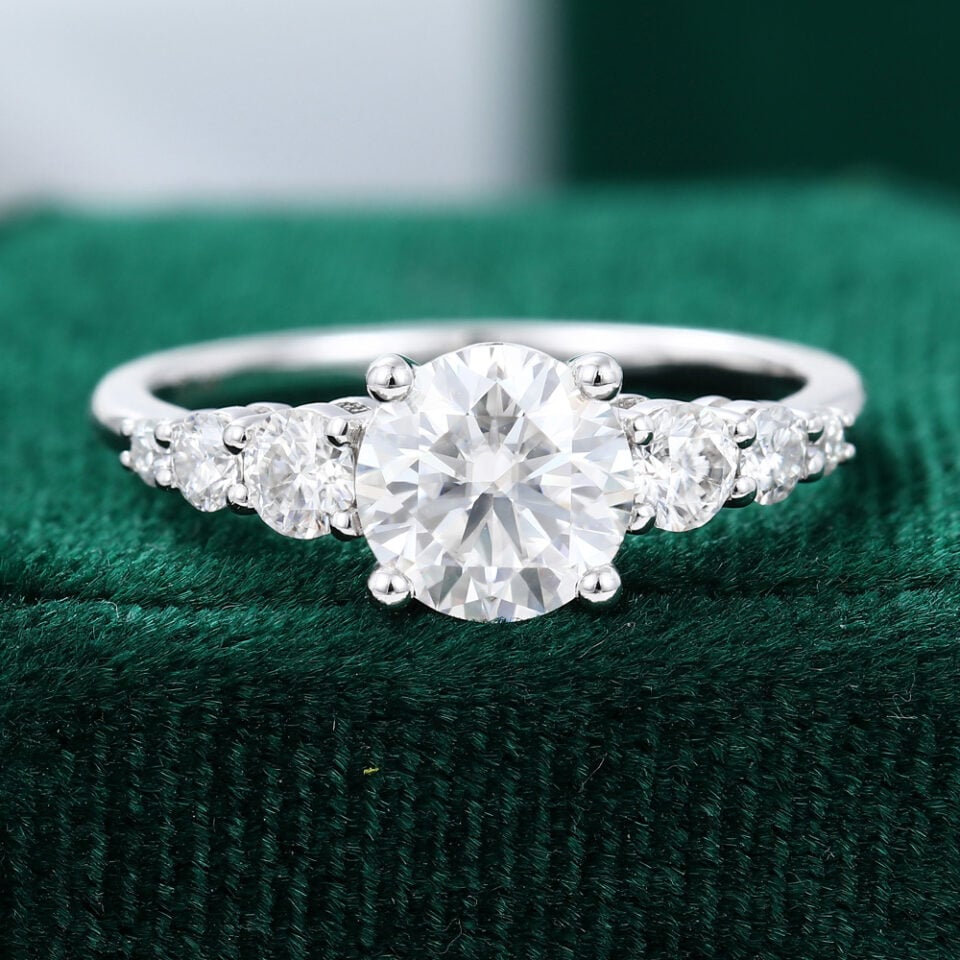What Is Moissanite? Everything You Need to Know About This Brilliant Diamond Alternative
Moissanite is becoming increasingly popular in the jewelry market, and it’s easy to see why. In this article, we’ll walk you through everything you need to know about this brilliant diamond substitute.
What Is Moissanite? Everything You Need to Know About This Brilliant Diamond Alternative
Moissanite is becoming increasingly popular in the jewelry market, and it’s easy to see why. In this article, we’ll walk you through everything you need to know about this brilliant diamond substitute.
What's Moissanite
What's Moissanite
A gemstone originates from space meteorites
A gemstone originates from space meteorites
Moissanite may look like a diamond at first glance, but it has a truly cosmic origin. This stunning gemstone was first discovered in 1893 by French scientist Henri Moissan, who found tiny crystals of a never-before-seen mineral in a meteor crater in Arizona. At first, he thought it was a diamond, but later tests revealed it was something entirely different: silicon carbide.
Natural moissanite is incredibly rare; in fact, all moissanite used in jewelry today is lab-created moissanite. But don’t let the term “lab-created” fool you. These gems are carefully grown under controlled conditions, replicating the intense heat and pressure of their natural origins. The result? A brilliant, durable, and ethical alternative to traditional diamonds.
Moissanite offers more than just a diamond look-alike — it has its own sparkle, character, and story. From a scientific marvel found in outer space to a meaningful symbol of love here on Earth, moissanite has quickly become one of the most beloved choices for modern couples seeking something extraordinary.
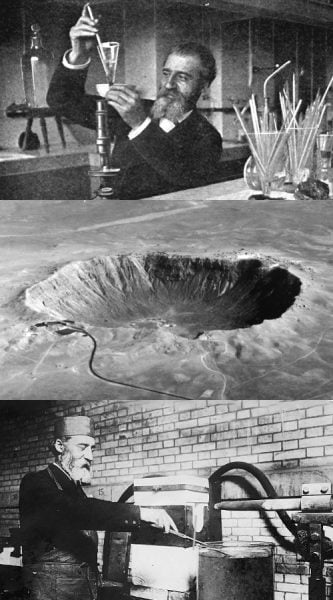
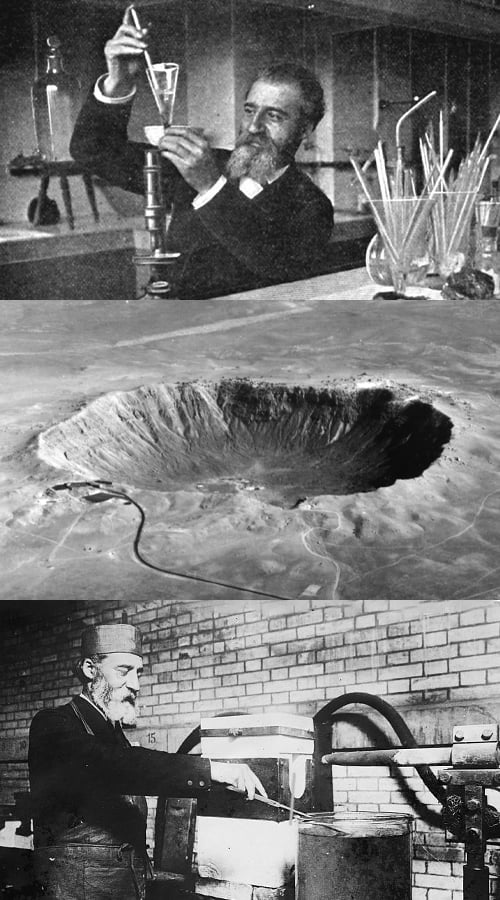
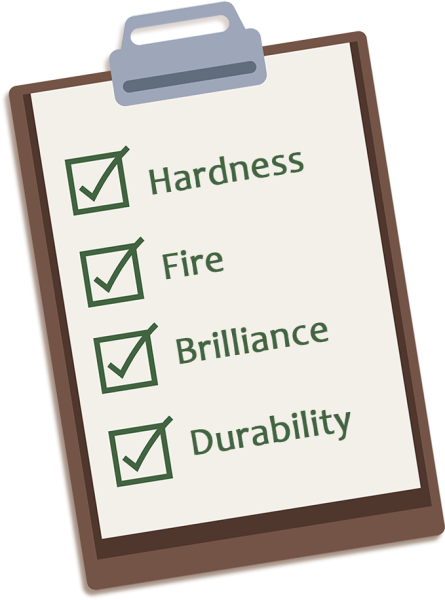
Properties of Moissanite: Hardness, Fire, Brilliance, and Durability
Properties of Moissanite: Hardness, Fire, Brilliance, and Durability
Properties of Moissanite: Hardness, Fire, Brilliance, and Durability
Properties of Moissanite: Hardness, Fire, Brilliance, and Durability
What makes moissanite truly stand out, beyond its dazzling beauty, are its exceptional physical properties. If you’re shopping for an engagement ring that can last a lifetime (or two), moissanite checks all the boxes.
Hardness: On the Mohs hardness scale, moissanite ranks at 9.25, just below a diamond’s perfect 10. That means it’s highly resistant to scratching compared to other gemstones — ideal for everyday wear.
Brilliance: Moissanite has a higher refractive index (2.65–2.69) than diamonds (2.42), which means it bends light more dramatically. The result? A fiery, rainbow-like sparkle that catches the eye from across the room.
Fire: Fire refers to a gemstone’s ability to disperse light into flashes of color. Moissanite’s fire is 2.5 times greater than that of diamonds! Yes, it has greater fire and gives it a lively, almost ethereal glow.
Durability: Besides being hard, moissanite is also extremely tough, which makes it highly resistant to breaking, chipping, or cracking. That makes it not just beautiful, but practical for daily life.
In short, moissanite isn’t just a “budget-friendly” option — it’s a performance gem. If you’re someone who wants your ring to keep up with your lifestyle, moissanite is more than up to the task.
Is Moissanite the Same as Cubic Zirconia?
Is Moissanite the Same as Cubic Zirconia?
It’s a common question — and the short answer is: NO, moissanite and cubic zirconia (CZ) are not the same thing.
While both are diamond alternatives, they differ dramatically in quality, durability, and brilliance:
| Feature | Moissanite | Cubic Zirconia (CZ) |
|---|---|---|
| Material | Silicon carbide | Zirconium dioxide |
| Hardness (Mohs) | 9.25 | 8–8.5 |
| Brilliance | Higher than diamond (2.65–2.69 RI) | Lower than diamond (2.15 RI) |
| Durability | Excellent (resists scratching) | Softer, scratches and clouds over time |
| Longevity | Lifetime gemstone | Wears down and dulls with regular wear |
| Cost | Higher than CZ, but still affordable | Very inexpensive |
Moissanite is a premium alternative to diamonds — built to last, used in engagement rings, and holds its beauty over time. Cubic zirconia, on the other hand, is much more affordable but also less durable and less brilliant, often used for fashion jewelry or temporary pieces.
So if you’re choosing a gemstone for an engagement ring or other meaningful jewelry, moissanite offers a much higher standard — one that’s made to last a lifetime.
Moissanite Color Grades Explained
& Moissanite's Own 4C System
People evaluate moissanite based on a similar grading system to diamonds; both have certain quality factors, but it doesn’t follow the exact same one. Understanding how moissanite is graded can help you make a confident and informed choice.
Moissanite Color Grades Explained
& Moissanite's Own 4C System
Moissanite Color Grades Explained
& Moissanite's Own 4C System
People evaluate moissanite based on a similar grading system to diamonds; both have certain quality factors, but it doesn’t follow the exact same one. Understanding how moissanite is graded can help you make a confident and informed choice.
Moissanite's Color Grades
Moissanite's Color Grades
Although moissanite’s color grading is based on the diamond system, moissanite is not classified as meticulously, but rather divided into ranges. Typically, moissanite comes in three color categories:
· Colorless (D–F): These moissanites appear icy white and are closest to traditional colorless diamonds.
· Near Colorless (G–H/I): These have a slight warmth, often preferred by those who want a more natural or vintage look.
· Faint Color (J–K and below): These moissanites have a noticeable warmth, similar to antique diamonds.
Unlike diamonds, moissanite’s color isn’t graded by GIA or IGI, but by the lab that produces it. At MollyJewelryUS, we offer DEF Colorless moissanites and carefully hand-pick each stone for consistency and beauty.
Moissanite vs. Diamond Grading Systems
Moissanite vs. Diamond Grading Systems
Here’s a side-by-side comparison to help clarify the differences:
| Category | Moissanite | Diamond |
|---|---|---|
| Color | DEF (Colorless), GHI (Near Colorless), below J (Faint) | D–Z scale (GIA standard) |
| Clarity | Typically VS or higher (eye clean) | Flawless to Included (FL to I3) |
| Cut | Branded as Excellent/Ideal for best sparkle | Graded by symmetry, polish, proportions |
| Carat Equivalent | Mainly based on mm size | True carat weight |
While gemstones are priced by carat weight, lab-grown gems like moissanite are typically cut into standard sizes. Unlike diamonds, which are often shaped to preserve as much weight as possible from the rough, moissanite is crafted with consistent dimensions, focusing on appearance and symmetry. Also, since the density of moissanite is lower than a diamond, even if they are the same size, they may not have the same carat weight.
Moissanite's Color Grades
Moissanite's Color Grades
Although moissanite’s color grading is based on the diamond system, moissanite is not classified as meticulously, but rather divided into ranges. Typically, moissanite comes in three color categories:
· Colorless (D–F): These moissanites appear icy white and are closest to traditional colorless diamonds.
· Near Colorless (G–H/I): These have a slight warmth, often preferred by those who want a more natural or vintage look.
· Faint Color (J–K and below): These moissanites have a noticeable warmth, similar to antique diamonds.
Unlike diamonds, moissanite’s color isn’t graded by GIA or IGI, but by the lab that produces it. At MollyJewelryUS, we offer DEF Colorless moissanites and carefully hand-pick each stone for consistency and beauty.
Moissanite vs. Diamond Grading Systems
Moissanite vs. Diamond Grading Systems
Here’s a side-by-side comparison to help clarify the differences:
| Category | Moissanite | Diamond |
|---|---|---|
| Color | DEF (Colorless), GHI (Near Colorless), below J (Faint) | D–Z scale (GIA standard) |
| Clarity | Typically VS or higher (eye clean) | Flawless to Included (FL to I3) |
| Cut | Branded as Excellent/Ideal for best sparkle | Graded by symmetry, polish, proportions |
| Carat Equivalent | Mainly based on mm size | True carat weight |
Is moissanite only available in Colorless?
Is moissanite only available in Colorless?
Not at all! Moissanite is not limited to just colorless. While the classic colorless moissanite (graded D–F) is the most popular for engagement rings, it actually comes in a variety of colors, including: Yellow, Green, Pink, Blue, Purple, Black, Champagne, etc. However, not all of these colors are created the same way. Moissanite colors fall into two main categories:
✅ Naturally Occurring or Stable Colors (Not Coated)
✅ Naturally Occurring or Stable Colors (Not Coated)
These colors are produced during the growth process and are part of the crystal structure — meaning they’re durable and long-lasting.
Yellow / Champagne Moissanite – Created by introducing trace elements like nitrogen. No coating is involved.
Green Moissanite – Achieved through controlled crystal growth. Naturally stable.
- Black Moissanite – Heat-treated. Stable & durable.
⚠️ Coated Colors (Surface Treatment)
⚠️ Coated Colors (Surface Treatment)
These moissanites get their color from a thin film coating applied to the surface. The coating can wear off over time, especially with frequent wear or exposure to friction.
- Blue Moissanite – Almost always coated. Vibrant but not as durable.
- Purple Moissanite – Typically coated and may fade or chip with daily use.
- Pink Moissanite – Mostly coated, pretty but the color may fade.
Is moissanite only available in Colorless?
Is moissanite only available in Colorless?
Not at all! Moissanite is not limited to just colorless. While the classic colorless moissanite (graded D–F) is the most popular for engagement rings, it actually comes in a variety of colors, including: Yellow, Green, Pink, Blue, Purple, Black, Champagne, etc. However, not all of these colors are created the same way. Moissanite colors fall into two main categories:
✅ Naturally Occurring or Stable Colors (Not Coated)
✅ Naturally Occurring or Stable Colors (Not Coated)
These colors are produced during the growth process and are part of the crystal structure — meaning they’re durable and long-lasting.
Yellow Moissanite – Created by introducing trace elements like nitrogen. No coating is involved.
Green Moissanite – Achieved through controlled crystal growth. Naturally stable.
Pink Moissanite – Some rare pink moissanite stones are uncoated and stable, though they’re less common.
⚠️ Coated Colors (Surface Treatment)
⚠️ Coated Colors (Surface Treatment)
These moissanites get their color from a thin film coating applied to the surface. The coating can wear off over time, especially with frequent wear or exposure to friction.
- Blue Moissanite – Almost always coated. Vibrant but not as durable.
- Purple Moissanite – Typically coated and may fade or chip with daily use.
- Champagne / Peach Moissanite – Usually coated, though some stable versions may exist.
- Black Moissanite – Most are coated or heat-treated. Not naturally black.
What Shapes Can Moissanite Gems Be Cut Into?
What Shapes Can Moissanite Gems Be Cut Into?
Moissanite is available in a variety of different cuts, more than you can imagine! Round, oval, pear, marquise… these are just the basics.
Thanks to moissanite’s exceptional hardness, it can be cut into nearly any shape with precision and brilliance. That means you’re not limited to the same old styles.
Want something a little more unexpected? Kite cut, hexagon, coffin, or even custom geometric shapes, moissanite can handle them all. These unique shapes are perfect for couples who want a ring that feels a little more “them” — something bold, artistic, or symbolic. Whether you’re dreaming of something romantic and soft or edgy and architectural, moissanite opens up a world of possibilities.
So don’t be afraid to think beyond the round brilliant. With moissanite, your dream shape can absolutely become reality.
Does moissanite come with a certificate?
Does moissanite come with a certificate?
Moissanite doesn’t usually come with a third-party gemological certificate like natural diamonds do, and that’s completely normal.
Because moissanite is lab-created under highly controlled conditions instead of a natural gemstone, most reputable jewelers are able to offer high quality moissanite stone, and it doesn’t show the same wide range of natural variations as mined diamonds. That’s why most moissanite stones aren’t sent to labs like GIA or IGI for grading. Additionally, sending a moissanite stone to a third-party lab can increase the overall cost without adding much value. Moissanite grading isn’t an industry-wide science, the way diamond grading is. Most moissanite stones are already cut to high standards and fall within a narrow clarity range (usually VS or better).
However, major manufacturers like Charles & Colvard typically include an authenticity card, which serves more like a warranty or proof of origin, rather than a detailed grading report. At MollyJewelryUS, we’re happy to provide a certificate of authenticity upon request, confirming the materials used, and proving the originality of the design. Anyway, it’s less about mimicking the diamond industry and more about standing behind what we create.
And here’s something important: because moissanite grading isn’t standardized industry-wide, some sellers may try to impress buyers with so-called “certificates” from unofficial labs. One name that pops up frequently is GRA, which is not a recognized gemological authority. These documents can look convincing, but have no actual credibility.
In the end, instead of obsessing over minute grading differences, most couples focus on the overall look, ethical value, and long-term sparkle.
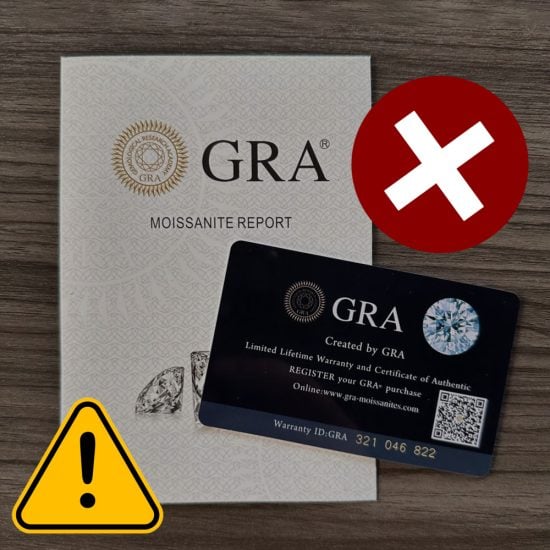
Does moissanite come with a certificate?
Does moissanite come with a certificate?
Moissanite doesn’t usually come with a third-party gemological certificate like diamonds do, and that’s completely normal.
Because moissanite is lab-created under highly controlled conditions, it doesn’t show the same wide range of natural variations as mined diamonds. That’s why most moissanite stones aren’t sent to labs like GIA or IGI for grading. Additionally, sending a moissanite stone to a third-party lab can increase the overall cost without adding much value. Moissanite grading isn’t an industry-wide science, the way diamond grading is. Most moissanite stones are already cut to high standards and fall within a narrow clarity range (usually VS or better).
However, major manufacturers like Charles & Colvard typically include an authenticity card, which serves more like a warranty or proof of origin, rather than a detailed grading report. At MollyJewelryUS, we’re happy to provide a certificate of authenticity upon request, confirming the materials used, and proving the originality of the design. Anyway, it’s less about mimicking the diamond industry and more about standing behind what we create.
And here’s something important: because moissanite grading isn’t standardized industry-wide, some sellers may try to impress buyers with so-called “certificates” from unofficial labs. One name that pops up frequently is GRA, which is not a recognized gemological authority. These documents can look convincing, but have no actual credibility.
In the end, instead of obsessing over minute grading differences, most couples focus on the overall look, ethical value, and long-term sparkle.
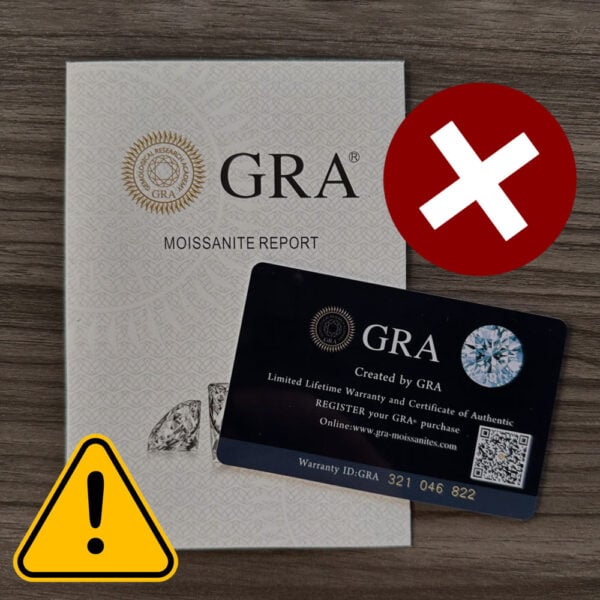
Why Choose Moissanite Over Diamond?
Why Choose Moissanite Over Diamond?
Advantages of Moissanite
Advantages of Moissanite
Moissanite is more than just a diamond alternative — it’s a reflection of modern love. It’s for couples who think independently, who care about value, ethics, and beauty, and who believe that meaning matters more than tradition. With its dazzling brilliance, durable performance, and conscious sourcing, we recommend choosing moissanite over diamond! The following is a summary of the advantages of moissanite. If you would like to see a side-by-side comparison details, check out our full guide: Moissanite vs Diamonds
✅ affordable
✅ affordable
Moissanite costs a fraction of the price of a diamond of similar size and quality, which means you can go bigger, bolder, or save that money for your honeymoon, home, or future plans.
✅ Eco-friendly qualities
✅ Eco-friendly qualities
Moissanite is lab-grown with minimal environmental impact — no mining, no land disruption, no toxic runoff. It’s a choice that’s lighter on the planet and better for future generations.
✅ durable Option
✅ durable Option
While no gemstone is indestructible, some gemstones are slightly harder and more durable for daily wear. On the Mohs Scale of Hardness, moissanite is rated as a 9.25 out of 10, which is higher than any gemstone used in jewelry besides diamond.
✅ guilty-free sparkle
✅ guilty-free sparkle
Because it’s created without unethical labor practices or conflict sourcing, moissanite lets you wear your sparkle proudly — with a clear conscience and no compromise on brilliance.
Frequently Asked Questions
Frequently Asked Questions
If you’re new to moissanite or considering it for your engagement ring, you probably have a few questions. Here are the most common ones we hear from couples exploring this stunning diamond alternative.
Is moissanite a real gemstone?
Yes! Moissanite is a real gemstone, originally discovered in a meteor crater by Dr. Henri Moissan. Today, all moissanites used in jewelry are lab-created, making them a sustainable and ethical choice without mining impact.
How is moissanite different from a diamond?
While moissanite looks very similar to a diamond, it’s made of silicon carbide rather than carbon. Moissanite sparkles even more brightly due to its higher refractive index and has slightly more fire (rainbow-like flashes). It’s also more affordable, making it a beautiful diamond alternative.
Does moissanite pass a diamond tester?
Yes. Moissanite can pass some thermal diamond testers because it conducts heat similarly to diamonds. However, professional jewelers use electrical conductivity testers or magnification to distinguish between the two accurately. Want to know why? Check out our Moissanite and Diamond Tester Guide
Is moissanite durable enough for an engagement ring?
Absolutely. Moissanite ranks 9.25 on the Mohs hardness scale, just below diamonds (10). It’s highly scratch-resistant and ideal for everyday wear, making it perfect for engagement rings and wedding bands.
Does moissanite lose its sparkle over time?
No, moissanite’s sparkle is permanent. It won’t fade, cloud, or dull over time — any loss of brilliance is usually due to surface dirt, which can easily be cleaned with warm water and mild soap.
How much does moissanite cost?
It depends a lot on its color grade, clarity, cut quality, and the metal setting around it. Typically, 1-carat moissanite sells for between $200 – $500.
How to clean and care for moissanite jewelry?
Simply soak your moissanite jewelry in warm, soapy water and gently brush it with a soft toothbrush. Avoid harsh chemicals or ultrasonic cleaners, especially if your ring has delicate settings or side stones. View Moissanite Cleaning and Care Guide for more details.
Can moissanite be set in any type of metal?
Yes! Moissanite pairs beautifully with white gold, yellow gold, rose gold, and platinum. The metal color can slightly influence the gemstone’s tone — cooler metals highlight icy brilliance, while warmer tones add a soft romantic glow.
What color and clarity best value for moissanite?
G-H, VS+ grade moissanite offers the best value for money, as they appear nearly colorless and flawless to the naked eye.
Does moissanite get cloudy?
No, moissanite doesn’t get cloudy over time. With regular cleaning to remove dirt and oil buildup, it stays clear and brilliant for years.
What colors do moissanite come in?
In addition to colorless/white, moissanite comes in a variety of colors, such as gray and green. Because it is lab-grown, it can be created in different colors as needed.
Does moissanite fog up?
Yes, but only for a few seconds. The relative humidity and any dirt or debris on the stone can affect the length of time the stone will stay fogged up, but it’s just a few seconds. On the other hand, zirconia and other diamond imitations will fog up and stay fogged up for a longer period.
How to tell if Moissanite is real?
Take your stone and hold it close to your eye. Get a penlight and shine it towards and through the stone that you are holding up to your eye (like this gentleman is doing.) If it is a Moissanite, it will have the rainbow, double refractory qualities of this image. If it is a diamond, it will look like this.
Can moissanite be scratched?
No. Moissanite is durable, tough, and extremely resistant to scratching and abrasion. With a hardness of 9.25, moissanite is harder than all other gemstones except diamond, meaning that it can only be scratched by a diamond or other moissanite stones which is very unlikely to occur.
Top Picks For You
Pear Cut Moissanite Infinity Pavé Engagement Ring
The design features a brilliant pear cut moissanite center stone, with pavé accents along the sides adding to its glow. Twisting gracefully into the shape of an infinity symbol (∞), the lines weave a timeless tale of eternal love. With every glimmer and curve, the Infinity Ring beautifully captures the promise of forever in each intricately placed stone.
Half Carat Oval Cut Moissanite Promise Ring Dainty Engagement Ring
This ring features a 4x6mm oval center stone of approximately 0.5 carats, making it an excellent choice for those with smaller hands. It represents the beautiful bond of love and commitment, reminding us that love knows no bounds and is not defined by a stone’s size.
Tapered Line | 1.5 Carat Oval Cut Moissanite Engagement Ring
A soft, tapered line of sparkle flows toward the center stone, like light gently gathering into a single, shining moment. In this version, an oval cut moissanite glows at the heart — timeless, luminous, and effortlessly romantic.
Classic Cluster | 1CT Marquise Cut Moissanite Engagement Ring
Timeless elegance meets modern brilliance with this 1CT marquise cut moissanite engagement ring. Featuring a dazzling classic side stones design, it offers unmatched brilliance, perfect for symbolizing your everlasting love.
Snowdrift | Round Moissanite Engagement Ring Set Cluster Bridal Ring Set – Symmetrical & Bold Accents
Inspired by the lovely charm of snowfall, the Snowdrift Bridal Set is crafted to commemorate the joy that arises when simple moments in life blend to form something extraordinary.
Oval Cut Moissanite Bridal Set Dainty Engagement Ring Set
This bridal set consists of an oval cut moissanite engagement ring and a curved wedding band. The engagement ring is set with round cut moissanite on both sides, a delicate and elegant design that perfectly presents the beauty of simplicity. The curved design of the wedding band complements the main band, symbolizing pure and eternal love.
Pear Cut Moissanite Engagement Ring Set Nature Inspired Bridal Set
Capturing the essence of nature’s beauty, the focal point of this exquisite bridal set is a pear shaped moissanite, complemented by the bouquet side stones. The wedding band features branches and leaves that perfectly match the engagement ring, adding a touch of whimsy. This set is an ideal expression of your love!
Classic Cluster | 0.5CT Oval Cut Moissanite Promise Ring Classic Side Stone Engagement Ring
Timeless elegance meets modern brilliance with this 0.5CT oval cut moissanite engagement ring. Featuring a dazzling classic side stones design, it offers unmatched brilliance, perfect for symbolizing your everlasting love.
Snowdrift | Half Carat Round Cut Moissanite Promise Ring Cluster Engagement Ring – Flip & Petite Accents
Inspired by the lovely charm of snowfall, the Snowdrift Ring is crafted to commemorate the joy that arises when simple moments in life blend together to form something extraordinary.
Marquise Cut Moissanite Engagement Ring Set with Carved Leaf Band
This elegant bridal set features a stunning marquise cut moissanite center stone, complemented by a matching band. Perfectly crafted for brilliance and sophistication, this ring set symbolizes timeless love and commitment.
Pear Cut Moissanite Blossom Engagement Ring Double Claw Setting
For this engagement ring, we used a cluster of round and marquise moissanite/diamonds on the side stones of the engagement ring to create a blooming ambiance. Enhancing the main stone while also bringing elegance to the overall design.
TwigLine | Moissanite & Emerald Engagement Ring Nature Themed Promise Ring
TwigLine traces a graceful path of nature’s elegance, where center brilliance meets organic vine accents in perfect flow. This version features a round moissanite at the center, with marquise emeralds shimmering around, like dewdrops resting on a twig at dawn.
1.5CT Oval Cut Moissanite Classic Side Stone Engagement Ring
Timeless elegance meets modern brilliance with this 1.5CT oval cut moissanite engagement ring. Featuring a dazzling classic side stones design, it offers unmatched brilliance, perfect for symbolizing your everlasting love.
Round Cut Moissanite Engagement Ring White Gold with Gradient Side Stones
For this engagement ring, we add a modern touch to the charm of the antique pieces we all love and use all the round cut moissanite to pay homage to timeless classics. The gradual side stones represent the fragments of memories that tell the story of the relationship between two people. As time passes, these moments of pure bliss slowly merge into one.
Pear Shaped Moissanite Bridal Set with Carved Leaf Band
Capturing the essence of nature’s beauty, the focal point of this exquisite bridal set is a pear shaped moissanite, complemented by the bouquet side stones. Elevate your special day with this captivating and elegant engagement ring set.
